
Featured Topic: Searching the Mathwire.com site

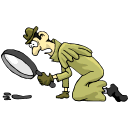
Quick Links
There are currently five different ways to search the Mathwire.com site for specific topics or activities. Quick links have been added to the upper left of the Home page and the main Mathwire search pages (A-Z List, Standards, Topics, Archives, What's New?) for your convenience in searching the site.
- Search Box: Type a word or phrase in the Search box at the top of the the home page to do a Google Search of the site on that word/phrase. This feature is also available on the major search pages of Mathwire listed at the upper left of the home page (A-Z List, Standards, Topics, Archives).
- Alphabetical List: Select A-Z List at the top of the Home page to go to an alphabetical listing of Mathwire.com activities and topics. So, select W to find the Who Has? cards, for instance, or G to find more information on Glyphs. Under S, you'll find Seasonal Math Activities which will take you to a menu for all of the fall and winter math activity collections.
- Math Standards: Select Standards at the top of the Home or New page for a listing of Mathwire.com activities and topics by NCTM Math Standard. Note that this list is still under development, but it's a good place to start looking for activities to address the different standards.
- Math Topics: Select Topics at the top of the Home page for a quick reference page to major topics on the site, such as Seasonal Math or Who Has? Activities.

- Mathwire Archives: Select Archives at the top of the Home page. Check through the
 Mathwire Archives to see past issues of the Home pages and past issues of the New pages, organized by month. This small Archives icon is available on both the Home and New pages.
Mathwire Archives to see past issues of the Home pages and past issues of the New pages, organized by month. This small Archives icon is available on both the Home and New pages.
- Home: Clicking this icon at the top of any Mathwire page will return you to the home page where you may access all of the search functions listed above.
- [not pictured above] New Additions to Mathwire.com: Select What's New? to go to the New page for the current month. This page details new additions to the site and provides links to those activities. This feature has been added to the quick links to make it easier to check what's been added since your last visit.
Eventually, these search options will appear at the top of each Mathwire page. For now, the Home page is a good place to start any search. Hopefully, these different options will allow users to easily locate information on specific topics.
New to Mathwire.com? The Alphabetical List (A-Z List) and the Mathwire Archives are good places for new visitors to start surfing through the site as they present an ordered tour through the activities and topics on the site.


Enter your email address below to receive notifications when new content is added to Mathwire.
NOTICE: If you have already subscribed to the Mathwire.com Updates but have not been receiving any notices, this may be due to your school's e-mail system that does not allow these mailings to be delivered. Please feel free to resubscribe using a different e-mail account rather than your school account.
Recent Additions to Mathwire.com
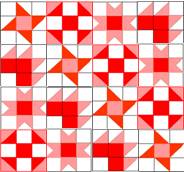
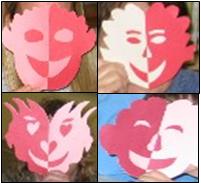
Added on January 26, 2008: Valentine's Day 2008 Math Activities
Activities in this 2008 collection include Valentine Probability, Valentine Discrete Math, Valentine Quilts and Valentine Symmetric Faces.
- See
 Valentine's Day 2008 to download PDF files for the various activities.
Valentine's Day 2008 to download PDF files for the various activities.
Added on January 21, 2008: Stand Up and Be Counted (Grades 5-8)
This problem requires students to analyze the pattern in the class game and to analyze how a change to the game impacts the results.
- Download
 Stand up and Be Counted problem with possible solution.
Stand up and Be Counted problem with possible solution.
Added on January 16, 2008: Algebra Function Problems (Grades 5-8)

These real-life application problems require students to write algebraic rules and evaluate those rules (functions) for specific situations. Students are also required to write about their findings.
-
 Bulldog Travel Agency asks students to evaluate car rental plans from three different companies and recommend the best match, given different family travel plans.
Bulldog Travel Agency asks students to evaluate car rental plans from three different companies and recommend the best match, given different family travel plans.
-
 Jen and Berry's Ice Creamery requires students to write a profit rule for the store, then use that rule (function) to evaluate the profit, given the number of customers each day.
Jen and Berry's Ice Creamery requires students to write a profit rule for the store, then use that rule (function) to evaluate the profit, given the number of customers each day.
- See more
 Problem Solving Resources for Grades 5-8.
Problem Solving Resources for Grades 5-8.
Added on January 15, 2008: Halfway Through the School Year Day
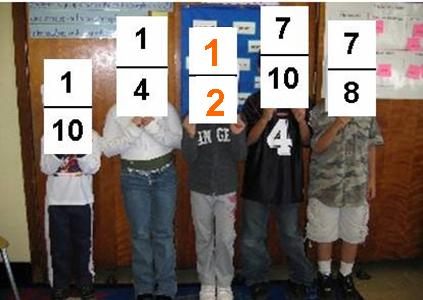
A special thanks to teachers who asked for suggestions for celebrating the "Halfway Through the School Year" day for older students rather than the 100th day of school. What a wonderful concept and so appropriate for 3rd-8th graders who are developing strong concepts of fractions. Here are some suggestions for activities to celebrate the day:
- Fraction Sort: provide index cards with various fractions written on them. Challenge students to quickly sort the fractions into two piles: greater than 1/2 or less than 1/2. Have students write about the mental process they used to accomplish this task. As an alternative, write the fractions on cheap paper plates or construction paper, hand them out to students and challenge students to quickly assemble into two groups: greater than 1/2 and less than 1/2 on either side of the 1/2 fraction holder. Extend the sorting activity by asking students to reassemble those two groups in least to greatest order to form a perfect fraction number line. Note: this will definitely produce some serious discussions!
- Many Names for 1/2: Play
 Climb the Ladder where all expressions must be equivalent names for 1/2. Students may use words, pictures, numbers, all operations, etc. to rename this landmark fraction. Use the
Climb the Ladder where all expressions must be equivalent names for 1/2. Students may use words, pictures, numbers, all operations, etc. to rename this landmark fraction. Use the  Blank Climb the Ladder Template inserted in sheet protectors so that students may record their mathematical expressions. Follow this activity with a class recording of varied expressions on chart paper or create a bulletin board of class results.
Blank Climb the Ladder Template inserted in sheet protectors so that students may record their mathematical expressions. Follow this activity with a class recording of varied expressions on chart paper or create a bulletin board of class results.
- Thirteen Ways of Looking at a Half: Challenge students to find the Thirteen Ways of Looking at a Half as suggested on the PBS site.
- First, demonstrate the activity from the
 Thirteen Ways of Looking at a Half website. It would be great to use an interactive whiteboard or large monitor to demonstrate the concept and emphasize the importance of record keeping.
Thirteen Ways of Looking at a Half website. It would be great to use an interactive whiteboard or large monitor to demonstrate the concept and emphasize the importance of record keeping.
- Next, have students work in pairs or small groups to record their findings on the
 Thirteen Ways Recording Sheet, developed at Mathwire to simplify student record keeping.
Thirteen Ways Recording Sheet, developed at Mathwire to simplify student record keeping.
- Finally, as students groups are sure that they have found all thirteen ways, let groups input the data on the
 Thirteen Ways of Looking at a Half website.
Thirteen Ways of Looking at a Half website.
- First, demonstrate the activity from the
- Quilt Blocks:
- Quilt Square Challenge: provide copies of the quilt squares and challenge students to form the different designs. Note that most of these designs are half black and half white because they are formed from blocks that are half and half. See
 Quilt Square Challenge for directions and PDF files for both the student squares and the teacher overheads.
Quilt Square Challenge for directions and PDF files for both the student squares and the teacher overheads.
- Have students explore traditional quilt blocks. See the
 Mathematical Quilting Menu for resources. Ask students to identify the fraction of the whole which is represented by each color.
Mathematical Quilting Menu for resources. Ask students to identify the fraction of the whole which is represented by each color.
- Quilt Treasure Hunt: provide quilt books, math-literature titles or online URLs on quilting. Challenge students to find quilt blocks in which one color represents half of the quilt block.
- Original Quilt Block Designs: Students may develop their own design or modify a traditional design so that one color represents half of the area of the quilt block.
- Quilt Square Challenge: provide copies of the quilt squares and challenge students to form the different designs. Note that most of these designs are half black and half white because they are formed from blocks that are half and half. See
- Math-Literature Connection:
 Math-Literature: Fractions to find information on the book and a link to a follow-up activity.
Math-Literature: Fractions to find information on the book and a link to a follow-up activity.
Added on January 5, 2008:  Algebra Help
Algebra Help
This math site is "a collection of leesons, calculators, and worksheets created to assist students and teachers of algebra. While useful in traditional Pre-Algebra or Algebra 1 courses, the site also contains a list of prime numbers and perfect squares which are great resources for middle school students as are many of the algebra topics which are also addressed in a traditional middle school math curriculum.
View all of the topics on  Algebra.Help.
Algebra.Help.
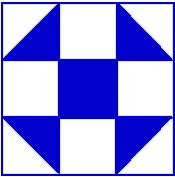
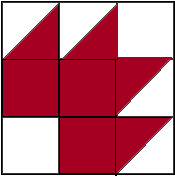

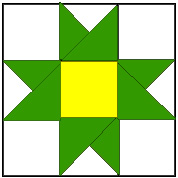
Added on January 4, 2008:  Mathematical Quilting
Mathematical Quilting
A study of quilts offers the chance to investigate tessellating shapes and an opportunity to apply transformational geometry as students slide (translate), flip (reflect) and turn (rotate) quilt pieces to create a traditional quilt or to create a tessellating quilt. Beyond the pure geometry, the use of color suggests different shapes within a shape and contributes to the beauty of the quilt design.
The activities in this series develop spatial sense in students through the use of quilt pieces. Literature titles help students learn about the American tradition of quilting. Links are provided to additional internet activities that address this topic.
The new Mathematical Quilt series includes: Quilt Square Challenge, Paper Block Quilts, Freedom Quilts, Math-Literature Connections: Quilts, and Quilt Links.
Visit the  Mathematical Quilts Menu to start the tour.
Mathematical Quilts Menu to start the tour.
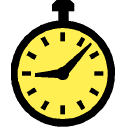
Added on January 4, 2008:  Division Bingo
Division Bingo
Add this site to the classroom list of basic facts practice. This online practice site offers three different levels of play for students to master division facts. Students are encouraged to complete a row in the least amount of time. Students may also print out their record times.
Check out  Division Bingo.
Division Bingo.
Added on January 4, 2008:  Times Table Practice
Times Table Practice

This Resource Room: Free-spirited Structured Multisensory Learning site presents both research links and a very structured approach to learning the times tables, designed to help students who need a more structured approach. This site would be suitable for a classroom approach or for home-study and reinforcement for parents to work with their children. Add this approach to your differentiation strategies to help students who are overwhelmed by multiplication facts. Mastering a few facts at a time, then adding others and integrating the practice of old and new facts is an effective strategy to help students who experience difficulty with the whole-table approach.
Check out  Times Tables Practice.
Times Tables Practice.
Added on January 4, 2008:  Math Lab Dictionary
Math Lab Dictionary

This is a great addition to the math curriculum resources and would benefit teachers, students and parents as an online resource. This math dictionary is especially suitable for Grades 4-9 as it includes mathematical terms, drawings and examples to illustrate the meanings.
Check out the  Math Lab Dictionary
Math Lab Dictionary

Mathwire Archives:

See Mathwire Archives for past issues of What's New on Mathwire.com and for past month's featured articles.